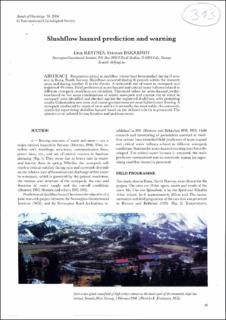| dc.contributor.author | Hestnes, Erik | |
| dc.contributor.author | Bakkehøi, Steinar | |
| dc.date.accessioned | 2023-10-25T17:52:18Z | |
| dc.date.available | 2023-10-25T17:52:18Z | |
| dc.date.issued | 2004 | |
| dc.identifier.issn | 0260-3055 | |
| dc.identifier.uri | https://hdl.handle.net/11250/3098801 | |
| dc.description.abstract | Parameters critical to slushflow release have been studied during 11 winters in Rana, North Norway. Slushflows occurred during 16 periods within the research areas and during another 13 in the district. A noticeable rise of water in snowpack was registered 49 times. Field predictors of acute-hazard and critical water influxes related to different snowpack conditions are identified. Threshold values for acute-hazard prediction based on five main combinations of winter snowpack and current rise of water in snowpack were identified and checked against the registered slushflows, with promising results. Cohesionless new snow and coarse-grained snow are most liable to start flowing. A snowpack reinforced by layers of crust and ice is normally the most stable. An automatic system for supervising slushflow hazard based on the defined criteria is presented. The system can be tailored for any location and problem owner. | en_US |
| dc.language.iso | eng | en_US |
| dc.publisher | Cambridge University Press | en_US |
| dc.subject | Avalanche-RnD | en_US |
| dc.subject | Snøskred-FoU | en_US |
| dc.title | Slushflow hazard prediction and warning | en_US |
| dc.type | Journal article | en_US |
| dc.rights.holder | The Author(s) | en_US |
| dc.source.pagenumber | 45-51 | en_US |
| dc.source.volume | 38 | en_US |
| dc.source.journal | Annals of Glaciology | en_US |
| dc.identifier.doi | 10.3189/172756404781814889 | |
